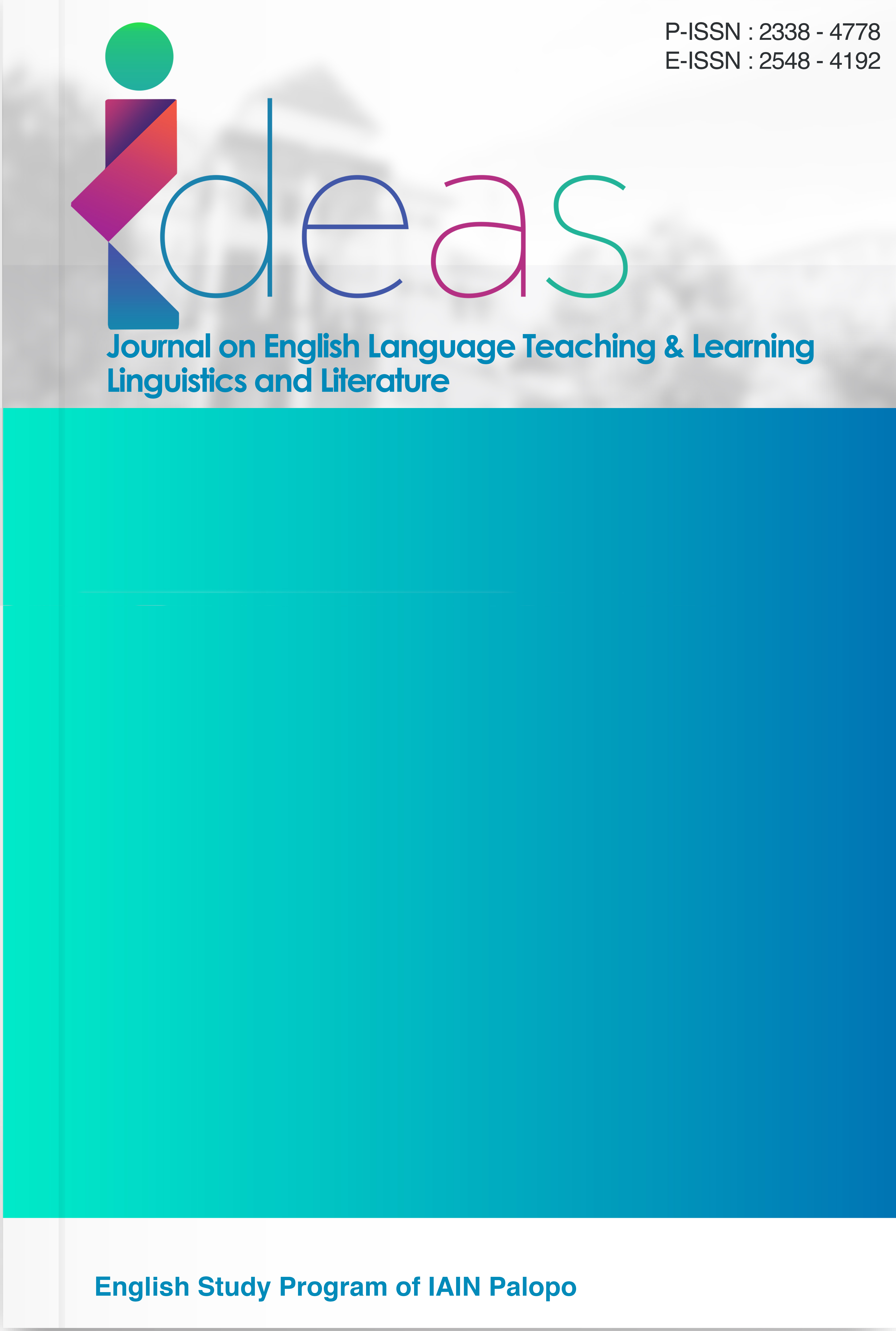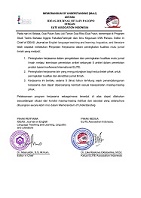Decoding TikTok Comedy: An In-depth Analysis of KPPS Humor
DOI:
https://doi.org/10.24256/ideas.v13i2.5806Keywords:
Humor, KPPS, TikTokAbstract
On social media, humour is frequently used to comment on current affairs. The purpose of this study was to identify the different kinds and purposes of humour utilized on TikTok about the KPPS phenomenon's virality. The researcher gathered 30 TikTok videos as data using the descriptive qualitative research method, and the study's two primary findings are as follows. First, the study identified five types of humour, with satire being the most prevalent (50%) among them. These categories include satire, irony, sarcasm, puns, and tall tales. Second, certain kinds of humour were employed for several reasons, including identification, differentiation, enforcement, and explanation. Additionally, a relationship between the kinds of humor and its purposes on TikTok was found. It implies that the speakers preferred specific kinds of humour for different reasons. Additionally, the speakers praised KPPS members above other culturally presumed acceptable occupations in Indonesia and denounced unethical actions by dishonest state officials or civil workers using a range of humour types and purposes. The popularity of the KPPS phenomenon and TikTok provides individuals with a safe and creative forum to voice their opinions while also raising awareness of the various social issues affecting their community.
References
Attardo, S. (2014). Encyclopedia of humor studies (S. Attardo, Ed.). SAGE Publications, Inc.
Attardo, S., Wagner, M. M., & Urios-Aparisi, E. (2013). Prosody and humor (S. Attardo, M. M. Wagner, & E. Urios-Aparisi, Eds.). John Benjamins Publishing Company.
Badan Pusat Statistik. (2025). Angkatan Kerja (AK) Menurut Golongan Umur, 2025.
Biro Teknis dan Hupmas KPU. (2014). Panduan KPPS: Pelaksanaan dan penghitungan suara di TPS. Komisi Pemilihan Umum.
Creswell, J. W. (2012). Educational research: Planning, conducting and evaluating quantitative and qualitative research. Pearson Education Inc.
Creswell, J. W. (2013). Research design: Qualitative, quantitative, and mixed methods approaches [Fourth Edition]. SAGE Publications, Inc.
Dalyan, M., Darwis, M., Rahman, F., & Latjuba, A. Y. (2022). Cultural discourse in Indonesian humor: A case study of some short dialogues. Theory and Practice in Language Studies, 12(5), 1009–1018.
Demjén, Z. (2016). Laughing at cancer: Humour, empowerment, solidarity and coping online. Journal of Pragmatics, 101, 18–30.
Dewanta, A. A. N. B. J. (2020). Pemanfaatan aplikasi tik tok sebagai media pembelajaran bahasa indonesia AANBJ Dewanta. Jurnal Pendidikan dan Pembelajaran Bahasa Indonesia, 9(2).
Firjatullah, M. M., Sunra, L., & Nur, R. H. (2021). Verbal humor in Hololive English selected clips. ELITERATE: Journal of English Linguistics and Literature Studies, 1(1), 1–11.
Hasan, N. (2014). Between the global and the local: Negotiating Islam and democracy in provincial Indonesia. In G. van Klinken & W. Berenschot (Eds.), In Search of Middle Indonesia (Vol. 4, pp. 171–198). KITLV.
Hasyim, N. N., & Hanidar, S. (2022). Verbal irony in a TV series The Office (US) Season 2. Lexicon, 9(2), 63–71.
Jakob, J. C. (2023). A pragmatic analysis of humor used in English meeting club. Linguistica, 12(2), 94–107.
Joshua, S. F. (2020). A pragmatic analysis of the discourse of humour and irony in selected memes on social media. International Journal of Language and Literary Studies, 2(2), 76–95.
Khamdamovna, M. U. (2020). Similarities and differences between types of comic. International Journal on Integrated Education, 3(9), 105–107.
Masruddin, M., & Nasriandi, N. (2022). Lexical and Syntactical Errors Performed by Junior High School Student in Writing Descriptive Text. IDEAS: Journal on English Language Teaching and Learning, Linguistics and Literature, 10(1), 1094-1100.
Masruddin, M., Amir, F., Langaji, A., & Rusdiansyah, R. (2023). Conceptualizing linguistic politeness in light of age. International Journal of Society, Culture & Language, 11(3), 41-55.
Meyer, J. C. (2000). Humor as a double-edged sword: Four functions of humor in communication Communication Theory, 10(3), 310–331.
Msimanga, M. J., Ncube, G., & Mkwananzi, P. (2021). Political satire and the mediation of the zimbabwean crisis in the era of the “new dispensation”: The case of Magamba TV. In The Politics of Laughter in the Social Media Age: Perspectives from the Global South (pp. 43–66). Springer International Publishing. https://doi.org/10.1007/978-3-030-81969-9_3
Ogungbee, E. O., & Omolabi, I. (2020). The pragmatics of coronavirus motivated humour on the social media . All Nations University Journal of Applied Thought, 8(1), 1–20.
Purwati, D. (2022). Humor Expression in Sarah Sichuan Talkshow . International Journal of Research on English Teaching and Applied Linguistics, 3(1), 30–45.
Rosita, F. Y. (2020). Politik wacana pada berita pilpres 2019 di media daring Vivanews. com Jurnal Komunikasi , 14(2), 155–168.
Rullyanti, M., & Nurdianto, N. (2019). Language style of humor on stand-up comedy video. JOALL (Journal of Applied Linguistics and Literature), 4(1), 60–68.
Sartika, L. A., & Pranoto, B. E. (2021). Analysis of humor in the Big Bang Theory by using relevance theory: a pragmatic study. Linguistics and Literature Journal, 2(1), 1–7.
Satvoldievna, U. D., & Qizi, R. K. B. (2020). Linguistic analysis of puns in the English language. Проблемы Современной Науки и Образования, 2(147), 38–40.
Shade, R. A. (1996). License to laugh: Humor in the classroom. Libraries Unlimited.
Singsatit, P., & Singhasiri, W. (2022). An analysis of lexical creativity and humor in English web-based gag cartoons. Thoughts, 1, 39–74.
Taecharungroj, V., & Nueangjamnong, P. (2015). Humour 2.0: Styles and Types of Humour and Virality of Memes on Facebook. Journal of Creative Communications, 10(3), 288–302. https://doi.org/10.1177/0973258615614420
Tuten, T. L. (2023). Social media marketing. SAGE Publications.
Ulandari, M. J., Zarina, Z., & Novrian, W. (2021). Analisis wacana politikus pada acara Catatan Demokrasi Kita Episode Misteri Kematian Episode Misteri Kematian Ratusan Petugas Kpps (Analisis prinsip kesantunan) . Jurnal Ilmu Hukum, Humaniora Dan Politik , 2(1), 67–76.
Vivona, B. D. (2014). “To laugh or not to laugh”: Understandings of the appropriateness of humour and joking in the workplace. The European Journal of Humour Research, 2(1), 1–18. Wearesocial. (2024). Digital 2024.
Weitz, E. (2016). Humour and social media. The European Journal of Humour Research, 4(4), 1–4.
Xi, Y. (2023). Adaptive agency: the satire genre and the motives behind its use in the era of social media in China. Humanities and Social Sciences Communications, 10(1), 1–12.
Downloads
Published
Issue
Section
Citation Check
License
Copyright (c) 2025 Listiana Ikawati

This work is licensed under a Creative Commons Attribution-ShareAlike 4.0 International License.
Authors retain copyright and grant the journal right of first publication with the work simultaneously licensed under an Attribution-ShareAlike 4.0 International (CC BY-SA 4.0) that allows others to share the work with an acknowledgement of the work's authorship and initial publication in this journal.
Authors are able to enter into separate, additional contractual arrangements for the non-exclusive distribution of the journal's published version of the work (e.g., post it to an institutional repository or publish it in a book), with an acknowledgement of its initial publication in this journal.
Authors are permitted and encouraged to post their work online (e.g., in institutional repositories or on their website) prior to and during the submission process, as it can lead to productive exchanges, as well as earlier and greater citation of published work (See the Effect of Open Access)




